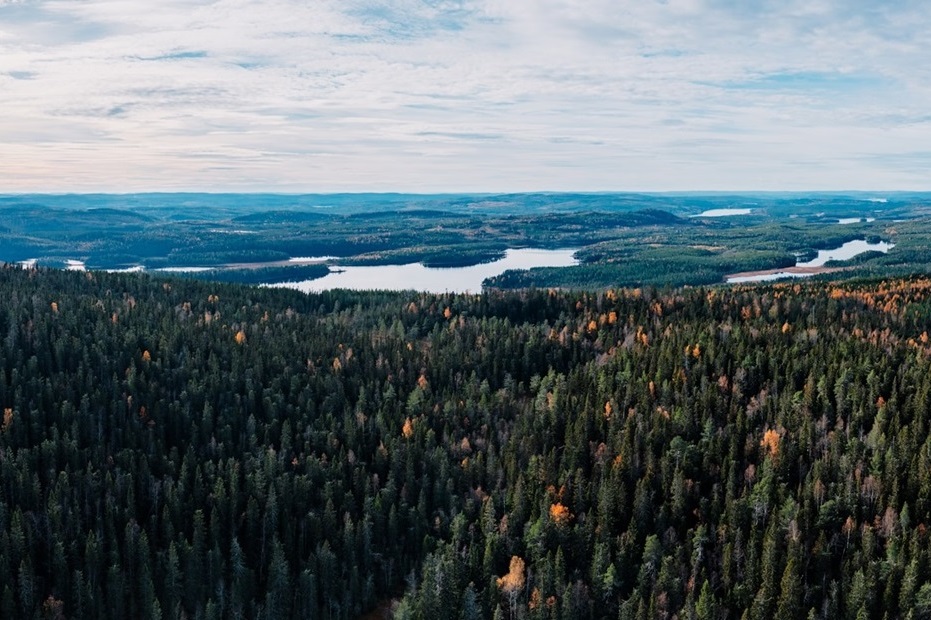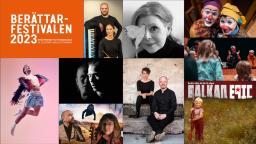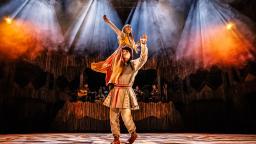Swedish Folk Tales – An Evolving Tradition
by Anna Maria Hellberg Moberg
Anna Maria Hellberg Moberg delves into the changing landscape of folk tales and storytelling traditions across Sweden.
When I first started researching Swedish folk tales, I was surprised and delighted by the sheer breadth of tales that have been documented over the centuries. Archives, books and other texts contain heroic, cautionary, and humorous tales in abundance, brimming with mythical and fairytale creatures, romance and derring-do. Folk tales are a rich treasure trove of Swedish culture.
Although there is definite overlap between fairytales and folk tales, where the two essentially differ is in purpose; whereas the main purpose of a fairytale could be said to entertain, to transport the listener (or reader) into an enchanted world where anything might happen, a folk tale, on the other hand, has a different purpose. Oral history passed down through the generations was originally deemed to be based on true stories, or at the very least to contain elements of truth, no matter how fantastical. The telling of folk tales was a way to keep local history and knowledge alive, passing it on to the next generation.

If I look closely at my own family history, there were several great storytellers a few generations back. My maternal grandfather, Karl, was fond of tall tales and humorous, sometimes downright lewd, stories. His wife, my grandmother Olga, wove together more personal stories, what today would be known as ‘life stories’ or ‘documentary storytelling’. They were born in the late 19th and early 20th centuries respectively – a time when rural Sweden was poor and in many parts sparsely populated – when folk tales played an important part in people’s everyday lives. This was also a time when there was great interest in collecting and compiling folk tales from many parts of the country, in order to preserve them in writing for future generations.
These efforts to collect stories from across the land were not new. There were previous ‘waves’ going as far back as the 17th century. Well-known folk tale collectors include Nils Gabriel Djurklou, who focused on the region of Närke (where he hailed from), as well as other parts of the country, in the mid-19th century; and his contemporary Gunnar Olof Hyltén-Cavallius, who worked with English-born George Stephens, based further south. Each collector arguably had his own bias and didn’t always write down the stories faithfully. Invariably from a different class background, with better education, some of these more literary men (they were mostly men, to my knowledge) seemingly couldn’t quite stop themselves from ‘refining’ the stories they collected. There were changes to the language used, including to folk tales told in dialect, and colloquialisms or swear words were sometimes filtered out. That said, the simple fact that these tales have been collected, written down and kept for posterity has left Sweden with an immensely rich archive of folk tales from the far north to the far south.
Folk tales are a rich treasure trove of Swedish culture.
The Institute for Language and Folklore (ISOF) archives, available to the public free online, have thousands of folk tales from across Sweden. Their online database is an excellent resource available to those interested in finding out more about the different tales told over the centuries. ‘ISOF was set up over a hundred years ago,’ Fredrik Skott, Head of the Department for Archives and Research in Gothenburg, tells me, ‘and it has four branches – Gothenburg, Uppsala, Lund and Umeå.’ The institute has been documenting all things related to language and folklore since the early 1900s. ‘Our work on folklore is divided into three areas; folk beliefs, folk customs, and folk poetry, which includes poems, folk tales, fairytales etc.,’ Fredrik explains.
Browsing the archives is a fascinating experience – to my amazement, I found folk tales from my mother’s tiny village, Gunnarskog, in western Värmland. The ISOF archives also brought home to me how similar some tales from different parts of the country are. Folk tales spring up organically, and they grow and morph with each telling, depending on the storyteller and their location. It can be very difficult to work out where some folk tales originate. Perhaps similar tales quite simply appear in different places at the same time. ‘There are so-called “wandering stories”, tales that have sprung up at the same time in different parts of the world,’ says Leif Stinnerbom, Head of Västanå Theatre (see box below), ‘and today it is very much accepted that the same story can turn up in different places, but with local versions, rather than the assumption that a tale has a definite unique place of origin.’
The Swedish landscape itself... can play a key part in narratives: mountains, forests, rivers, lakes, sea, coastline, fields, and farmland can and often do take centre stage.
Something far more certain than the origins of a folk tale, however, are the reoccurring themes, which include the tight-fisted miser getting their comeuppance, often in brutal ways; self-sacrifice and bravery in the face of injustice; and an abundance of what you might refer to as supernatural phenomena and fairytale creatures. The reason the latter regularly sneak into folk tales, rather than just fairytales, is undoubtedly because at the time the tale was first told, many people believed in their existence. My grandfather used to talk about ‘the little people’ who lived on the farm, and the tomte, a sort of house elf with a very distinctive appearance – small in stature, often with a beard, wearing grey clothes and a red woollen cap – who was mostly kind and useful, but if you ever crossed him, you’d be very sorry. Ghost stories are another folk tale favourite. When I was growing up in Värmland, there was a place called Apertin that we all knew was haunted by a lady ghost. No one I knew had ever seen her, or knew the origins of the tale, but we all believed in the haunting. This ghostly tale is still told today. Another reoccurring theme is the Swedish landscape itself, which can play a key part in narratives: mountains, forests, rivers, lakes, sea, coastline, fields, and farmland can and often do take centre stage. In many stories the landscape becomes a living, breathing force. Interestingly, forests, rather than being seen as frightening, scary, forbidding places, can instead be places of refuge, beauty, and solace. Some stories focus on epic adventures and legends, monsters, giants, trolls, and witches, devils and hauntings, but many are simply humorous, ordinary tales, focusing on the more mundane activities of rural life.
Throughout the 20th century, folk tales from different parts of Sweden continued to be collected, with stories appearing in print, as well as in the ISOF archives. From the early 1900s to the early 2000s, Swedish society underwent tremendous changes. The telling of folk tales and local legends by the hearth, around the kitchen table or when working the land, as in my grandparents’ time, was becoming increasingly rare. There were fears that storytelling was a dying art – something only old folks did.
When I started researching this feature, one of the key questions I asked myself was, ‘are folk tales still told today?’. I’ve come to the conclusion that the answer is yes, but not as much as before and not in the same way. The tales we tell and how we tell them have shifted focus. There is greater variety and a greater focus on the personal. Life stories, documentary storytelling and urban legends, the latter arguably a modern version that has elements of a folk tale, have become increasingly important. You could say that storytelling has evolved into two distinct branches – the traditional and the modern – but there is room, and a need, for both.
The shift from ‘dying artform’ to ‘alive and kicking’ began in the late 1980s, when a number of new initiatives transformed both the folk tale scene and the art of storytelling in Sweden. If we look at the picture today, folk tales are still told, but now they have company and wide-ranging company to boot, in the shape of documentary storytelling, festivals, competitions and more. I talked to Mats Rehnman from Fabula Storytelling in Stockholm, who is one of the key people behind the storytelling revival in Sweden. ‘In the late 1980s I was working as a children’s book author and illustrator,’ he tells me, ‘but I soon noticed that telling stories, rather than reading from a book, was a big hit with the kids when I visited schools, and that’s how it started.’ Mats became a full-time storyteller and, inspired by his visit to Beyond the Border storytelling festival in Wales, he set up Fabula Storytelling in the early 2000s together with three others, having worked solo up until then. Mats also helped ensure that the Swedish Storytelling Network got going, and a version of this organisation is still going strong, with many local and regional member organisations.
You could say that storytelling has evolved into two distinct branches – the traditional and the modern – but there is room, and a need, for both.
Around the same time as Mats Rehnman was finding his way into storytelling in the 1980s, Per Gustavsson, a librarian from Ljungby, was having a similar experience. ‘When I started storytelling in the 1980s, there were actually a number of other people who started roughly at the same time. I started my storytelling career as a librarian and I found that there was great interest in hearing a good story and reviving old stories. It was through my work as a librarian that I came across Mickel i Långhult (Mickel of Långhult), a prolific storyteller who hailed from the area and whose stories were documented by Gunnar Olof Hyltén-Cavallius in the mid-1800s.’ Over the years Per Gustavsson has become one of Sweden’s best-known storytellers himself, instrumental in setting up the regional Storytelling Network Kronoberg. He has reinvented the character of Mickel of Långhult, acting the part of Mickel in many of his performances. In 1990 Per created Sweden’s longest-running storytelling festival in his hometown Ljungby, and the festival remains very popular to this day, now in its 33rd year (see box below). Many changes have taken place over the years, but folk tales are still the main theme of the festival. Traditional folk tale storytelling remains important in the area surrounding Ljungby, in the region of Småland in the mid-south, where the tradition goes back several hundred years. Storytelling Network Kronoberg was the driving force behind the creation of a unique museum located in Ljungby, The Museum of Legends, as well as the so-called Land of Legends in the surrounding area. ‘The area includes 43 places associated with local legends and folk tales that can all be visited’, says Tine Winther, Head of Operations at Land of Legends, ‘and we’ve been a UNESCO accredited NGO since 2014 with 25,000 visitors annually.’ (see box below).
The 1980-90s can be seen as a big wave of folk tale and storytelling revival throughout Sweden, one that has continued into the 2000s. Festivals sprang up, associations were started and at a local level there were storytelling cafés and gatherings. This movement gathered real momentum, and even though the humble folk tale was part of this wave, there was also more emphasis on innovation, on widening the scope and allowing for new perspectives. Or indeed, older perspectives too, but less mainstream. This was a time when Sami stories started to come more to the fore – Giron Sami Theatre was established in 1992. Another theatre with a strong emphasis on local stories is Västanå Theatre in Värmland, in the far west. Established as early as 1972, it’s been instrumental in creating a local theatre tradition in the west of Sweden (see box below).
The last few decades have seen a further shift. Competitions (so-called ‘storytelling slams’) have become popular, and the internet plays a greater role, with the rise of urban legend websites. But in terms of professional storytellers, there is a generational gap at present. ‘There are very few storytellers under the age of 30, or even, I’d go as far as to say, under 50,’ says professional storyteller Anders Holmberg, who started his storytelling career working with young addicts. He soon noticed how powerful and transformative storytelling could be in his work. ‘My focus has always been on how to use storytelling in real life situations, how useful and empowering it can be,’ he tells me.
How storytelling is used is currently seeing a big shift, not just in Sweden, but in many countries. The humble folk tale seems to be more on the backburner, while life stories or documentary storytelling is taking centre stage. This can be seen as an exciting new development, opening up opportunities for professional storytellers: suddenly everyone from marketing executives to corporate businesses is discovering the power of a good story and wants to learn how to spin a good yarn. For better or for worse. There is a risk that the power of storytelling gets watered down when taken over by corporate interests. That said, perhaps the old folk tales remain safe, set as they often are in a certain time and place, with very local connections. Despite all the changes in society, two things remain true: stories endure – they may change, morph, evolve or lay hidden for a time, but they will reemerge; and people need stories. They need to hear them and they need to tell them. The humble folk tale can still make people laugh out loud, gasp in horror, shed a tear and often recognise themselves in the story. That, to me, remains their enduring appeal.

Storytelling Festivals
The longest-running storytelling festival in Sweden was set up in Ljungby, in the south, by Per Gustavsson and Bengt Göran Söderlind in 1990. Over the years the festival, which takes place annually in June, has widened its scope to include music as well, but the main focus is still the traditional folk tale, with an emphasis on the local area and storytelling legend Mickel of Långhult. There is also an annual ‘Mickel Prize’ given to a person or organisation promoting oral storytelling traditions, stories and folk tales.
Up north, in Skellefteå, there is another, long-established storytelling festival with a focus that’s both local and international. The festival is affiliated to the regional theatre, Västerbottenteatern, home to the Nordic Storytelling Centre. ‘In 2023, we celebrated our 15th festival,’ Malin Åberg, programme coordinator at the Nordic Storytelling Centre tells me. ‘The festival always takes place mid-October and in 2022 we had 10,000 visitors. Over 50 local organisations participate and events, which are mostly free, take place all over the region.’

Storytelling Centres – Traditional and Modern
A key centre for oral storytelling, keeping the folk tale alive in Sweden, is the Museum of Legends, as well as the surrounding area, known as Land of Legends, in southern Sweden. The museum was created in 1999 and the focus is firmly on the old-style oral folk tale. ‘Many of the people who collected and compiled the folk tales that have subsequently become well-known have their roots in the area known as the Land of Legends (Ljungby, Alvesta and Älmhult),’ Per Gustavsson, a storyteller who was instrumental in the creation of the museum, tells me. Since 2018 it’s been on the UNESCO Register of Good Safeguarding Practices. The museum is a popular tourist attraction, with information in Swedish, English and German.
More modern in their approach, but still with a storytelling focus, is Västanå Theatre, from my own neck of the woods, Värmland. The innovative theatre is housed inside the so-called Storytelling Barn and performances mix music, dance, and theatre, with a great focus on costumes and design. ‘The oral folk tale tradition belongs to everyone,’ says Leif Stinnerbom, who founded the theatre. ‘The theatre was set up in 1972, but it’s changed and our focus has shifted. Since 1990 the aim has been to create a local theatre tradition, or even to imagine what such a tradition might look like.’ Being of Sami, as well as Värmland descent, Leif’s most recent production was the traditional Sami story, Daughter of the Sun.
Another key player on the Swedish storytelling scene with a more modern approach is Fabula Storytelling. Set up by Mats Rehnman as a festival in 2004 and as a company with four members in 2005, Fabula is based in Stockholm and has been instrumental in furthering storytelling traditions of all kinds in Sweden. Fabula Storytelling remains involved in many national and international projects, furthering storytelling for people from different age groups and backgrounds.
Anna Maria Hellberg Moberg
Anna Maria Hellberg Moberg is a UK-based, Swedish writer, journalist, and storyteller. She’s the author of 25+ works of nonfiction and fiction, including travel writing, food writing, three children’s books and two collections of short stories for adults. She’s currently working on a collection of Swedish folk tales for The History Press, due to be published in autumn 2024. Anna Maria writes, gives talks and tells stories in English, Swedish and Spanish. For more information see: www.amhellbergmoberg.co.uk.
